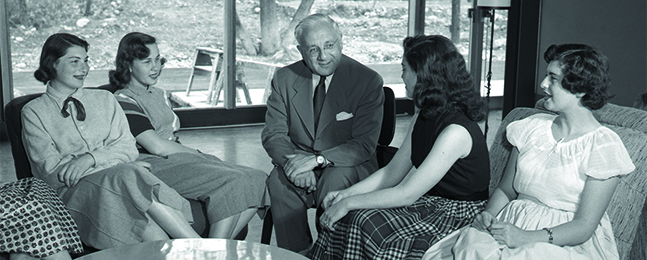Perspective
A Singular Experiment in Higher Education
What does it mean to be a Jewish-founded university in the 21st century?

Courtesy Robert D. Farber University Archives and Special Collections Department, Brandeis
President Abram L. Sachar, H’68, chats with students in 1952
by Stephen Whitfield, GSAS PhD’72
How do we measure Brandeis University’s achievements and limitations over the arc of three-quarters of a century? One way is to test the vision of 1948 against the reality inevitably imposed by history.
Early in fall 1948, founding president Abram L. Sachar, H’68, delivered his inaugural address at Boston’s Symphony Hall. For two decades, he had been a major figure in American Jewish institutional life. He had authored the ambitious and synoptic book “A History of the Jews.” Yet surprisingly, although Sachar in his address briefly referred to the “responsibility of the Jewish people” and to “Jewish leaders,” he omitted any mention of Jewish ideals or, more broadly, Judaism as the transmitter of these values.
Over the next 75 years, much of Brandeis’ tangled and inconclusive effort at institutional self-definition could have been avoided had Sachar’s silence on this topic been maintained. But, of course, that was impossible. Vast numbers of undergraduates who might have attended other schools enrolled at Brandeis precisely because of the difference its Jewish heritage is supposed to make. The expression of this heritage — whether formulated as love of learning, devotion to social justice, or the appreciation of difference itself — easily gets ensnarled in frustrating complication and controversy. Yet no resolution is entirely satisfactory, even as the quest for meaning generates endless intellectual excitement.
Without fixed ideological boundaries, Brandeis has remained singular, and paradoxes have dogged its status as a Jewish-sponsored nonsectarian institution. It has never trained rabbis, but it cancels classes on Shemini Atzeret. There has never been a full-fledged Department of Religion, yet the three chapels became the campus’s most distinctive architectural feature when they were dedicated in 1955.
In Colonial New England, institutions of higher learning were established by refugees from religious persecution abroad. Yet Sachar’s inaugural address makes no explicit allusion to the historic plight of the university’s Jewish founders. He did not note the lingering academic antisemitism that helped form the rationale for Brandeis. Nor did he mention the Final Solution, stopped three years earlier by force of arms; perhaps he did not need to. Not until 1995 did one of Sachar’s successors, Jehuda Reinharz, PhD’72, H’11, make strengthening Jewish communal connections one of four “pillars” of the university’s mission.
Although Sachar was surprisingly mute on the ethnic aura that has been an inescapable feature of Brandeis history, he was voluble in articulating what constituted liberalism. Liberalism meant envisioning a society in which individual aspiration might be most fully realized, even if — or especially if — the unfair and irrational barriers of discrimination could be removed. Thus, at Brandeis, Sachar affirmed in his inaugural address, every academically qualified prospective student or faculty member would be welcomed “regardless of race or creed or color.” Quotas would be anathema. No one would “ever be chosen on the basis of population proportions, or genetic or ethnic or economic distribution.”
Liberalism, therefore, required treating everybody without regard to the social categories (gender, ancestry, faith, nationality) that might be attached to them. The alternative to this prospect of opportunity is labeled as prejudice — perceiving others as part of some larger collective that can be corrupted into misleading stereotypes. The battle against prejudice was looking genuinely hopeful in the immediate postwar era. Americans were realizing as never before that bigotry was incompatible with democracy.
In 1948, Sachar was already wrestling with the evidence of disparate results among the efforts of minority groups. Their experiences, talents, and aptitudes did not lead to the same finishing line at the same time. Therefore, should every group adopt similar standards and beliefs? In his inaugural speech, Sachar answered by opting for pluralism, asserting that all segments of the populace must cultivate their own special heritage. He rejected a goal of assimilation that would extinguish diverse cultures and traditions, and articulated a faith that “honesty in the exploration of truth” should be open to all, if bigotry could be erased and its victims unshackled. He was declaring that the liberal arts (as the etymology suggests) should prioritize the exercise of freedom rather than the pursuit of equality.
The subsequent history of American liberalism is, to no small degree, the repudiation of this idea, replaced by an awareness that the social attributes Sachar wanted absent from admissions decisions and hiring procedures could not easily be abandoned. Today, although prejudice has become almost universally stigmatized, it has proved more ineradicable than most people realized in 1948.
Identity is now a phenomenon to which attention must be paid, so that the excluded and the marginal can be recognized. To take one example, the most recent faculty-activities questionnaire at Brandeis poses two questions about faculty members’ contributions to current and future scholarship — but three questions about contributions to the achievement of diversity, equity, and inclusion.
In the 21st century, the proportion of Jewish undergraduates at Brandeis has declined, and the proportion of international students has increased. This dramatic shift poses challenges to a Jewish-sponsored nonsectarian university that were unforeseen in 1948. A Jewish legacy is bound to become more elusive, and a singularity once taken for granted is more difficult to define.
At 75, Brandeis faces a question: How can the explicit and emphatic membership in groups be squared with the individualist ideal of awakening one’s curiosity and encouraging independence of thought?
Stephen Whitfield is the Max Richter Professor of American Civilization, Emeritus.
